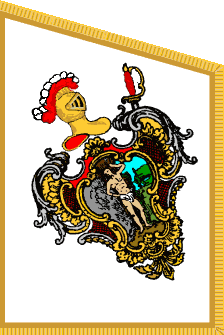
 by Joseph McMillan
by Joseph McMillan
Last modified: 2004-12-29 by joe mcmillan
Keywords: rio de janeiro | saltire | saint sebastian | armillary sphere | arrow | dolphin | phrygian cap |
coat of arms |
Links: FOTW homepage |
search |
disclaimer and copyright |
write us |
mirrors
In Brazões e bandeiras do Brasil (1933), Clóvis Ribeiro presents a series of four flags of the city of Rio de Janeiro dating back to 1808. The first three are actually the flags of the senate of the municipal chamber (senado da câmara municipal), the fourth that of the old Distrito Federal, or Federal District, which was identical with the municipality until the capital was moved to Brasília in 1967.
Joseph McMillan, 14 November 2002The first flag was used by the municipal senate during the reception of the Portuguese
royal family when it arrived to take refuge from Napoleon's occupation of
the mother country on 8 March 1808. It was a white trapezoid with gold trim
all around and gold fringe around the three free sides. On the center was
an ornate shield with an oil painting of St. Sebastian (patron of the city)
tied to a tree and pierced with arrows, the shield ensigned with a plumed
knight's helmet.
Joseph McMillan, 14 November 2002
The second flag, used from 1822-1831, was basically a trapezoidal version of
the national flag of the Brazilian empire with the arms raised to overlap
the upper corner of the yellow lozenge, and with gold trim and fringe added. The arms are ensigned with a royal rather
than imperial crown. The directive to change to the imperial crown
was issued on 1 December 1822, and this flag probably predated that.
On the other hand, Ribeiro notes that the royal crown continued to be widely used
after 1 December 1822 because an official but incorrect pattern with the
old crown was sent out from Rio shortly after the decree was issued.
Joseph McMillan, 14 November 2002